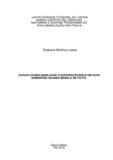| dc.creator | Lopes, Daisiane Molinos | |
| dc.date.accessioned | 2018-12-14T21:19:22Z | |
| dc.date.available | 2018-12-14T21:19:22Z | |
| dc.date.issued | 2018-07-20 | |
| dc.identifier.uri | http://repositorio.ufsm.br/handle/1/15111 | |
| dc.description.abstract | Our study to investigate the wettability of flat and structured surfaces in pillars based on
two- dimensional simulations, using the Potts cellular model (CPM). We can find a
superhydropic character on the surface when they presented: (I) High value of the contact
angle (θ > 150°) formed between the liquid and the surface and (II)low hysteresis of the
contact angle (Δθ< 10°). The drop on a surface may have two states of wettability: Cassie-
Baxter, the liquid remains on the pillars surface, known as heterogeneous state or "fakir",
and Wenzel, the liquid enters the cavities of the surface and is called state
homogeneous. These studies show that between these two states there is an energy
barrier that, when overcome, causes the transition of states. In our previous works, we
also presented a model of at surface with a hydrophobic character, in order to obtain a
surface with superhypophobic behavior (minimum contact between the drop and the
surface). We studied which parameters can intensify this behavior and facilitate a possible
transition. Thus, our structure of the surface with pillars and we vary the distance
between them (b) and their height (h) to determine the transition zone of states. From the
transition diagram, it was possible to analyze the behavior of parameters, such as
contact angle, hysteresis and solid contact fraction in the regions near and far from the
transition and also. We analyze how the parameters of the Potts model interfere in the
wettability. In this study of the transition of states, we compared our model with the
molecular dynamics model and therefore, having our results consistent with the experimental
results found in the literature. Finally, we analyze how the reentrancy on the
pillars influence the transition line. | eng |
| dc.description.sponsorship | Coordenação de Aperfeiçoamento de Pessoal de Nível Superior - CAPES | por |
| dc.language | por | por |
| dc.publisher | Universidade Federal de Santa Maria | por |
| dc.rights | Attribution-NonCommercial-NoDerivatives 4.0 International | * |
| dc.rights.uri | http://creativecommons.org/licenses/by-nc-nd/4.0/ | * |
| dc.subject | Transição | por |
| dc.subject | Cassie-Baxter | por |
| dc.subject | Wenzel | por |
| dc.subject | Superhidrofobicidade | por |
| dc.subject | Transition | eng |
| dc.subject | Superhydrophobic | eng |
| dc.title | Estudo da molhabilidade e superrepelência em duas dimensões usando modelo de Potts | por |
| dc.title.alternative | Study of wettability and super-repellency in two dimensions using Potts model | eng |
| dc.type | Tese | por |
| dc.description.resumo | Nosso estudo sobre molhabilidade de superfícies planas e estruturadas em pilares é
baseado em simulações bidimensionais, com o auxílio do modelo celular de Potts
(CPM). Podemos encontrar um caráter superhidróbico na superfície quando forem
apresentados: (I) Alto valor do ângulo de contato (θ > 150°) formado entre o líquido e a
superfície e (II) baixa histerese do ângulo de contato (Δθ< 10°). A gota sobre uma superfície
poderá ter dois estados de molhabilidade: Cassie-Baxter, o líquido permanece
sobre os pilares da superfície, conhecido como estado heterogêneo ou “faquir”, e Wenzel,
o líquido entra nas cavidades da superfície e é chamado de estado homogêneo.
Estudos mostram que entre esses dois estados existe uma barreira de energia que,
quando superada, ocasiona a transição de estados. Em nossos trabalhos anteriores,
modelamos uma superfície plana com caráter hidrofóbico, a fim de obter uma superfície
com comportamento superhidrofóbico (mínimo contato entre a gota e a superfície).
Estudamos quais parâmetros podem intensificar esse comportamento e facilitar uma
possível transição. Assim, estruturamos a superfície com pilares e variamos a distância
entre eles (b) e sua altura (h) para determinar a zona de transição entre estados. A
partir do diagrama de transição, foi possível analisar o comportamento de parâmetros,
como o ângulo de contato, a histerese e a fração de contato sólido, nas regiões próximas
e distantes da transição. Analisamos como os parâmetros do modelo de Potts
interferem na molhabilidade. No estudo da transição de estados, comparamos nosso
modelo com o modelo de dinâmica molecular, tendo, assim, resultados coerentes com
os resultados experimentais e teóricos encontrados na literatura. E por fim, analisamos
como as reentrâncias sobre os pilares influencia na linha de transição. | por |
| dc.contributor.advisor1 | Mombach, Jose Carlos Merino | |
| dc.contributor.advisor1Lattes | http://lattes.cnpq.br/7661373078999069 | por |
| dc.contributor.referee1 | Thomas, Gilberto Lima | |
| dc.contributor.referee1Lattes | http://lattes.cnpq.br/2581725109296683 | por |
| dc.contributor.referee2 | Villetti, Marcos Antonio | |
| dc.contributor.referee2Lattes | http://lattes.cnpq.br/8504489050993642 | por |
| dc.contributor.referee3 | Denardin, Juliano Casagrande | |
| dc.contributor.referee3Lattes | http://lattes.cnpq.br/5425237044575885 | por |
| dc.creator.Lattes | http://lattes.cnpq.br/7262730172725803 | por |
| dc.publisher.country | Brasil | por |
| dc.publisher.department | Física | por |
| dc.publisher.initials | UFSM | por |
| dc.publisher.program | Programa de Pós-Graduação em Física | por |
| dc.subject.cnpq | CNPQ::CIENCIAS EXATAS E DA TERRA::FISICA | por |
| dc.publisher.unidade | Centro de Ciências Naturais e Exatas | por |



